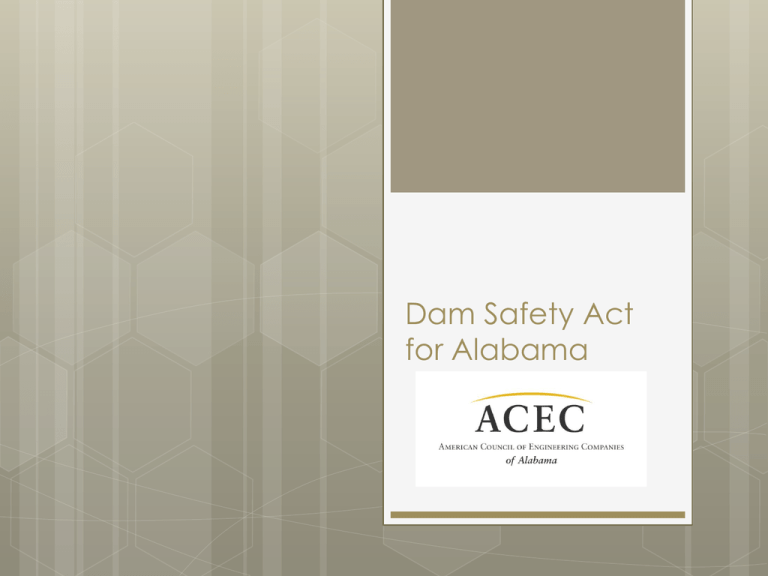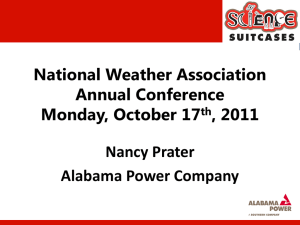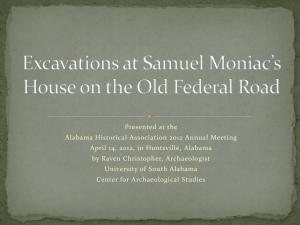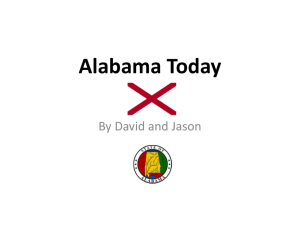A State Dam Safety Program in Alabama
advertisement

Dam Safety Act for Alabama Baldwin Hills Dam Disaster - 1963 IRS Code 501-(c )-(6), non for profit organization, advocating for the engineering profession in Alabama. ACEC is a federation, headquartered in Washington, DC, with offices in each state of the nation. ACEC's roots date back to 1909 when a small group of engineers in private practice established the American Institute of Consulting Engineers (AICE), the forerunner of ACEC. Today ACEC is a large federation of 51 state and regional councils representing the great breadth of America's engineering industry. ACEC member firms employ hundreds of thousands of engineers, architects, land surveyors, scientists, and other specialists, responsible for more than $200 billion of private and public works annually. Member firms range in size from a single registered professional engineer to corporations employing thousands of engineering and industry related professionals. 2014 marks the 50th anniversary of ACEC’s operation in Alabama. Members Firms: 53 Associates/Sustaining Firms: 17 Annual Operating Income: $400,000.00 What we know: Alabama Dam Safety Act Alabama is the only state in the nation without a dam safety program. The location and condition of most dams in Alabama is unknown. Most Alabama dams do not have an Emergency Action Plan. There is a lack of information for citizens and emergency management officials to plan for an emergency in the event of a dam failure or misoperation. Alabama’s National Inventory of Dams (NID) Red: High Hazard Failure or mis-operation would cause loss of human life and significant property destruction. Yellow: Significant Hazard Failure or mis-operation will cause significant property destruction Through a FEMA grant, ADECA’s Office of Water Resources updated some dam safety inventory information in 16 counties using aerial imagery and found that NID dams in those counties increased from 214 to 866. Presently, ADECA’s Office of Water Resources reports that 2/3 of the state has been inventoried. Black: Low Hazard Failure would cause minimal property destruction. THIS MAP DATA IS OVER 30 YEARS OLD! Bill history: Alabama Dam Safety Act 2003 Bill Dialogue with Stakeholders 2008 Bill HB454 Provides for inventory and classification of dams, but no regulation of dams. Rep. Wood, Canfield, McCutcheon, Laird, Bridges, Fite Bill reportedly died in committee Office of Water Resources, ADECA Bill died in Commerce Committee Office of Water Resources, ADECA 2014 Bill HB610 Rep. McClurklin and leaders in a community within her district contacted ASDSO. A national model bill was introduced, in joint effort with ASCE. Rep. McClurklin, Hill and Wallace Bill died in Commerce and Small Business Committee Office of Water Resources, ADECA Provisions: Alabama Dam Safety Act An Alabama dam safety program comprehensively regulates dam safety in Alabama. If enacted, the bill would establish statewide procedures for the construction, alteration, repair, operation, abandonment and removal of dams. 1. The bill would require inspection of existing dams. 2. Oversee remediation of deficient dams. 3. Permit the construction of new dams. 4. High Hazard Potential and Significant Hazard Potential dams must have an approved Emergency Action Plan. Dam owners would work with local officials and dam owners on emergency preparedness to mitigate losses resulting from dam failures. Dam Safety Act for Alabama The advocates Stakeholders Public Entities - Federal, State, County, Municipal, etc. Private owners & Land Developers Mining Industries Utilities Agricultural Industries Electric, Water, Sewer, etc. Farming/Forestry/Pulp Paper Parks & Recreation USACE USDA/Natural Resources Conservation Service Manufacturers River Users Alliances Homeland Security Home Owner Groups FEMA/Alabama EMA Dept. of Industrial Relations Soil and Water Conservation Commission Elected Officials Downstream Communities/Property Owners common core A dam safety program is a life/safety matter. Engineers have an ethical responsibility to protect the public. This bill makes sense for Alabama. This matter has a tremendous environmental impact. Engineers have an obligation to influence meaningful legislation to protect the People of Alabama. moving forward Start with the pre-negotiated bill version. Initiate dialogue; seek feedback from Stakeholders. Educate legislative leadership and governor on the need for this legislation. Initiate a Stakeholders meeting this fall. Introduce bill early in the 2015 regular session. Stay the course. Contact Us Renée Anne Casillas ACEC/Alabama Executive Director 531 Herron Street | Montgomery, Alabama 36104 P. 334.264.1500 | F. 334.264.0099 | www.aceca.org Kevin Blake, PE ACEC/Alabama President, 2014-2015 Principal Engineer, VP CTL, Inc. 1211 Newell Parkway | Montgomery, Alabama 36110 P. 334.260.9174 | F. 334.260-9177 | M. 334.430.5951 Alain Gallet, PE, FACEC ACEC/Alabama Past President & Legislative Chairman Senior Principal, National Director - Energy Sector Terracon Consultants | M. 205.541.7956 | P. 205.942.1289 Joe Meads, PE ASCE/AL Legislative Chairman, Past ACEC/Alabama Birmingham Area Vice President Principal/Owner Sain Associates, Inc. | P. 205.940.6420








